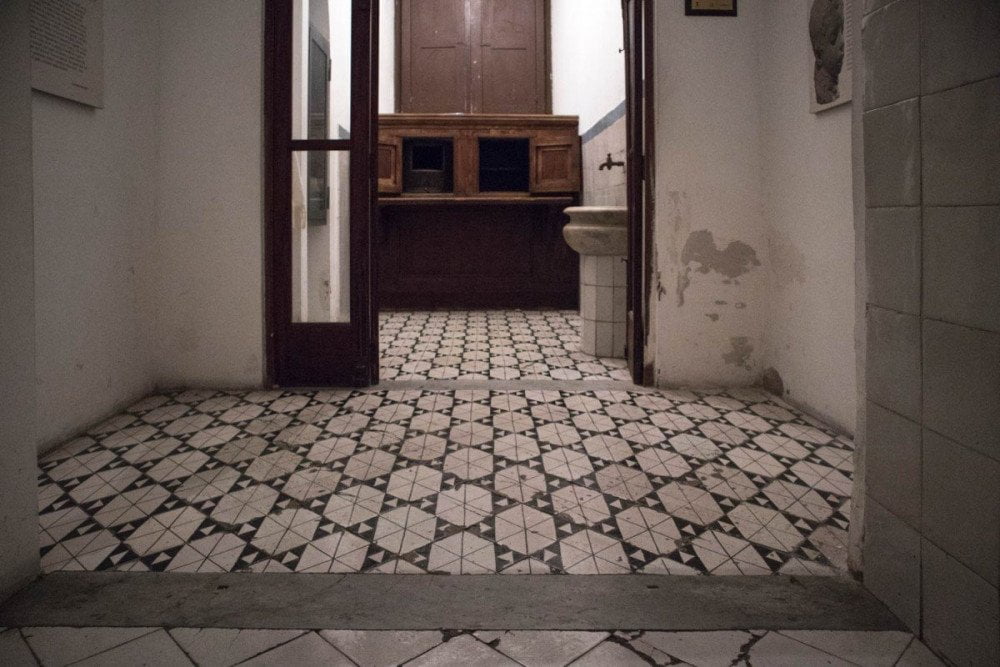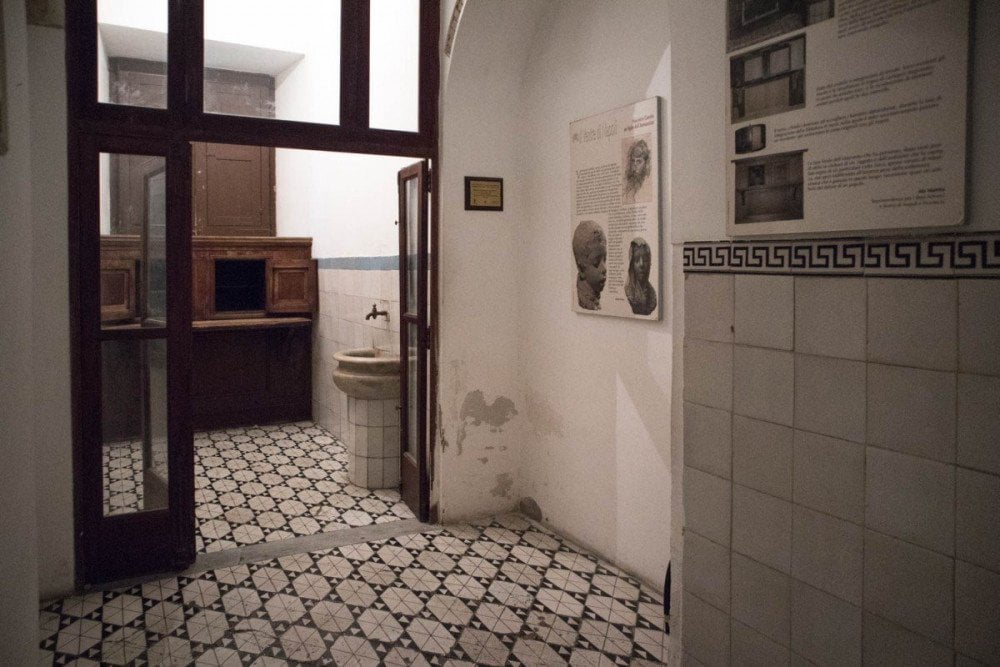In Naples, at the Basilica of Santissima Annunziata Maggiore, you will find Italy’s oldest and most famous Ruota degli Esposti, a baby hatch designed around 1300 for mothers to anonymously leave their unwanted newborns for adoption. While this historical feature is no longer in use and now serves as a relic of the past, it was once a very active institution. In this article, you will learn how to visit the Ruota degli Esposti in Naples and explore its legacy.
Table of Contents
Ruota degli Esposti: A Glimpse into Its Purpose and Impact
The Ruota degli Esposti (also known as the Rota degli Esposti) was a wooden wheel used in Italy to anonymously abandon unwanted infants. These children, often illegitimate or born into families too poor to care for them, were placed in the wheel through a flap that rotated, aligning with an opening on the inside where the child could be picked up and cared for.
ORGANISE YOUR TRIP TO NAPLES
Save money on your trip to Naples with the Naples Pass and enjoy access to popular attractions like the underground city tour and the Catacombs of San Gennaro, along with unlimited public transport.
Stay connected throughout Italy by getting an Airalo eSim online for reliable data and phone coverage. Don’t forget to secure your Heymondo travel insurance for peace of mind and be covered for any surprises on your adventure!
Several Italian cities, including Naples, Milan, Florence, and Rome, once had their own Ruota degli Esposti. Although today, the abandonment of children is universally condemned, these foundling wheels were widely used in past centuries as a means of protecting vulnerable infants.
Once abandoned, the infants were cared for by religious congregations that operated the baby hatches. These religious orders would provide the children food, shelter, and early vocational training. In an era before formula milk, infants were initially entrusted to wet nurses who cared for them as part of their own families before someone later adopted the children.

How the Ruota degli Esposti in Naples Worked
In Naples, mothers unable or unwilling to care for their newborns would leave them in the Ruota degli Esposti, the foundling wheel operated by the Congregation of the Santissima Annunziata. Located within the complex of the Basilica of Santissima Annunziata Maggiore, the baby hatch was part of a larger institution that included a church and an orphanage.
The Ruota degli Esposti in Naples is also the source of one of the city’s most common surnames: Esposito, meaning “exposed” or “abandoned”. The foundling wheel in Naples operated from around 1300 until 1875.
However, even after its closure, infants continued to be left on the steps of the Annunziata church for several years. The orphanage itself remained active until 1980, providing a home for abandoned children not placed with adoptive families.
Why Mothers Abandoned Babies at the Ruota degli Esposti
In the past centuries, mothers abandoned their babies for various reasons, most commonly due to poverty or because the child was illegitimate. In some cases, mothers would place identifying items—such as saints’ medals, jewellery, or documents—alongside their infants in the hope of being recognised and taking them back later.
What Happened to the Abandoned Children
The foundling wheel operated with a simple yet effective mechanism. It consisted of a rotating wooden box shaped like a wheel mounted on a metal pin. The wheel had an opening where mothers could place their babies discreetly without being seen from the inside.
Turning the wheel, the child was brought into the Basilica of Santissima Annunziata Maggiore, where a bell rang to alert the nun on duty to attend to the infant. While primarily intended for newborns, the wheel was sometimes used for older children.
Abandoned children were often referred to as ”figli della Madonna”, that means children of the Virgin Mary, ”figli d’a Nunziata”, children of the Annnunziata (Basilica), or simply ”esposti”, meaning “exposed”.
From the 16th century onward, the nuns recorded each child’s arrival. These records noted the date, time, age, physical features, and any distinguishing marks.
In some cases, parents would leave a note, a medallion, or even coins with the child, hoping that if their circumstances improved, they could later reclaim the infant. However, more often than not, the children were left with only the clothes they wore.
The Future of Abandoned Children
You rarely find information about the Ruota degli Esposti in Naples in tourist literature, especially in English. Also inside the buildings of the Basilica of Santissima Annunziata Maggiore, you’ll find only a few informational signs in Italian.
To uncover the fate of the abandoned children who passed through the wheel, I turned to online sources, though I encountered many different versions of what became of them. Here some information that seems more truthful, quoted from several sources.
Girls Without Dowries
A common tradition for girls without dowries was the Rito del Fazzoletto (Rite of the Handkerchief), a practice to encourage their marriage. It sounds terrible today, but apparently, it offered girls a better future than remaining unmarried.
The nuns who ran the Annunziata orphanage would parade the girls of marriageable age in the courtyard, where potential suitors could observe them. If a man was interested in a girl, he would throw a white handkerchief at her. The girl had to pick it up to accept the proposal or drop it to reject it.
Vincenzo Gemito
One of the most famous individuals from the Ruota degli Esposti was Vincenzo Gemito, a renowned Neapolitan artist known for his draughtsman, sculptor, and goldsmith skills.
His surname was supposed to be Genito, meaning “generated” in old Italian, but due to a transcription error, it became Gemito. His story offers an example of redemption, from abandonment at the Ruota degli Esposti to the success of a renowned artist who made significant contributions to Italian culture.

Esposito: The Most Common Neapolitan Surname, Born from the Ruota degli Esposti
The surname Esposito is one of the most common in Naples, and it originated from the Ruota degli Esposti. The word “Esposito”, in fact, means “exposed” in Italian, and it was given as a surname to infants abandoned in the foundling wheel.
The earliest recorded use of the surname dates back to the 1st January 1623, in an official Ospedale dell’Annunziata document referencing a two-year-old child named Fabritio.
The practice of assigning the surname Esposito to abandoned children continued for centuries. However, in 1811, under French rule, the government mandated the use of fictitious surnames for foundlings, aiming to protect these children from the social stigma associated with being abandoned. The goal was to avoid marking them with what was then considered an infamous label.
Basilica of Santissima Annunziata Maggiore: More Than Just a Baby Hatch
The Basilica of Santissima Annunziata Maggiore in Naples was much more than just a church with a baby hatch. It housed a convent, a hospital, an orphanage, and a conservatory for poor girls without families. Founded in 1318, it was managed by the Congregation of the Santissima Annunziata.
While the hospital is still operating today, the Basilica and the Ruota degli Esposti (foundling wheel) are open to the public and can be visited free of charge.
Information for Visiting the Ruota degli Esposti in Naples
The Ruota degli Esposti is located inside the Basilica of Santissima Annunziata Maggiore complex, situated on Via Annunziata, a lively street in Naples where cars are often parked haphazardly, and clothes hang from the balconies of nearby buildings.
The church’s façade, partially obscured by the cars, hints at its rich history. However, during my visit, the entire complex had a somewhat dim and neglected appearance.
To access the Ruota degli Esposti, you enter through the same entrance as the hospital. The site is open to the public, free of charge, from Monday to Saturday, between 9:00 am and 1:30 pm. During my visit, I noticed a few signs explaining the history of the foundling wheel, though the room itself appeared somewhat neglected, almost semi-abandoned.
Given its historical significance, I’m not sure whether the site has since been restored (I hope so). Still, when I visited, you could freely enter and explore despite a doorman being present at the entrance.
Ruota degli Esposti (foundling wheel)
Basilica of Santissima Annunziata Maggiore
Via Annunziata, 34
80139 Naples
Where to stay in Naples
Naples boasts numerous accommodations, from hotels to seaside flats. With my frequent visits to Naples, I can suggest several options. For an authentic experience in the historic center, consider The Idyll Boutique Apartment in the Spanish Quarter. This charming flat features parquet floors and a fully equipped kitchen, conveniently close to major attractions. Alternatively, the upscale Relais Della Porta, situated on Via Toledo, places you a short distance from landmarks like the San Carlo Theatre. Last but not least, the Santa Chiara Boutique Hotel, located near the Dante metro stop, offers a continental or Italian breakfast to start your day.
Ruota degli Esposti in Naples: Final Thoughts
Visiting the Ruota degli Esposti in Naples was an incredibly moving experience for me despite the overall neglect of the structure. The thought that, in the past, babies were abandoned due to being illegitimate or for economic reasons is almost unimaginable today.
However, the Ruota degli Esposti is an important piece of Italian history that we should not forget. In my opinion, it’s definitely worth visiting to reflect on this poignant part of Naples’ past.
If you’re familiar with the history of the baby hatch in Naples or have already visited the Ruota degli Esposti, feel free to share your thoughts in the comments. I’d love to hear your perspective!
